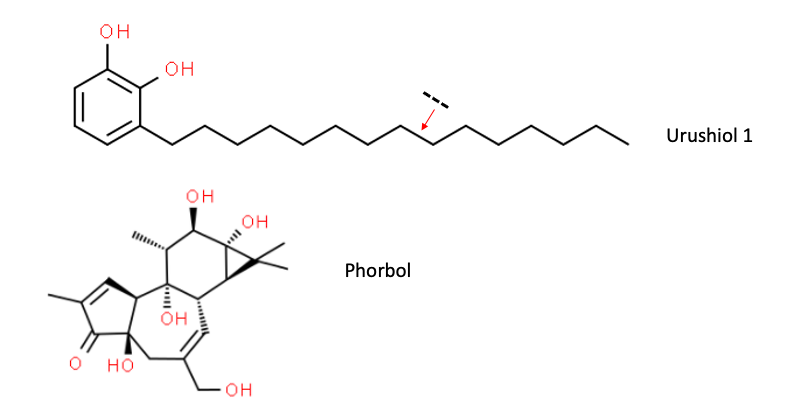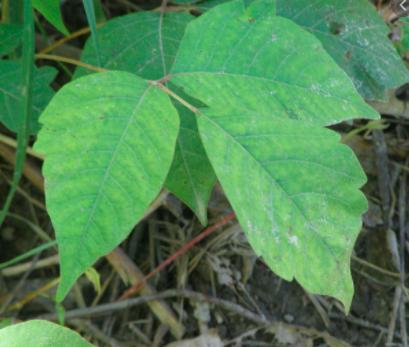There sure is a seemingly unlimited supply of things for Americans to argue about, but the "In the Garden" section of the New York Times would seem to be a safe harbor from the nonstop debate over everything that has gripped this country since the year WXYZ (WXYZ means that I dare not even suggest a year that nonstop arguing began, because people will argue about that).
Although the tone of the discourse over how to handle poison ivy (N.Y. Times, 5/13/21) does not rise to the level of, let's say, that of the invasion of the Capital, there are some goodies in there, especially in the comments section.
First, a little chemistry
The "poison" in poison is thought to be a chemical called urushiol, but this is not strictly true. The real poison is a metabolite of urushiol. For those of you who are losers with no life interested in knowing why it is so toxic, I wrote about this in 2018. Hint: it's the same reason that Tylenol is toxic.
Plant-based chemicals, my a$$
The latest craze in marketing is "plant-based." As if there is something magical and wonderful about a chemical just because a plant makes it. However, this is true in a sense. Some of the most toxic substances in the world come from plants.
Urushiol is bad news, but it's a bag of candy corn compared to what's in the Everglades' Manchineel tree. The chemicals in that tree are so toxic that you can die just from standing under it. Here are the chemical structures of urushiol and phorbol, the offending chemical from the manchineel tree (1).

The chemical structures of urushiol and phorbol. There are several analogs of urushiol found in poison ivy differing only by the number and placement of carbon-carbon double bonds. When a double bond is found in the 7-8 position on (red arrow) the chemical is called urushiol 2. It is wise to avoid all of them.
Minor disagreements with the author
For the most part, Margaret Roach's Times article is both interesting and accurate. However, she maintains that today's poison ivy is more toxic because of climate change. I could be wrong, but this seems like a bit of a stretch. She also suggests that you try to dig the stuff up when it first emerges from the ground (the origin of the term "here, you do this!") or smother it with cardboard (takes 1-2 years) before resorting to Round-Up. Hell no! I say fight chemicals with other chemicals. To her credit, Ms. Roach, unlike some of the chemophobic readers who left comments, does not go ballistic when Round-Up is mentioned. She notes that it is really the only option for dealing with large quantities of the mature vine.
Speaking of the readers...
Reader's comments provide a treasure trove of material for anyone looking to make fun of people, a responsibility I take very seriously. Even though the ~500 comments are from Times readers and the quality of these comments easily surpasses those left by the collection of morons who comment on Yahoo News stories, there are still some beauties in there. There's even a comment from someone who knows what he's talking about (2)!
Here's a thoroughly biased sampling:
Lisa from Indiana writes:
"[The best thing I have found] is soaking in warm bath with an oatmeal-filled sock."
That's probably not going to work any better than an oatmeal-filled jock.
Pan Metron, location (and planet) unknown, offers this gem. He starts out OK. Sort of.
[First I would] pick a large bunch of manzanita leaves, boil them for a long time, then apply the cooled liquid.
But this does not last long...
For really bad cases, scratch the rashes till they ooze.
It is generally well-accepted that one should not do this.
Or this:
Then pour bleach on them. Hurts real bad but it’s a sure fire cure.
Pan does not tell us when he was kicked out of dermatology school.
Beejay (clever, no?) from Illinois writes:
I recently read on The People's Pharmacy (a great site) that rubbing a banana peel over the affected area helps.
The research is mixed here. Some experts claim that banana rubbing shortens the duration of the rash to two weeks. Others claim 14 days. Beejay does not specify where he got his expertise in banana rubbing.
Scott from Oklahoma clearly has a flair for decor, but you might want to avoid his house during the holidays (emphasis mine):
The vines did make beautiful Christmas decorations draped over our antiques, fitted with dried grasses and berries and other things I’d brought home from my walk along the river.
Finally, Brenda from Tennessee writes:
I’ve had an invasion in my flower garden for years. There’s no room to dig it out. My husband is very allergic and I am not, and our dog goes in there, so I pull it out, seal it in bags, and throw it away.
Well, Brenda may be allergic to poison ivy, but she is obviously immune to misplaced modifiers. Either that, or she actually did seal the dog in a bag and throw it away. (3)
Brenda, please let us know how the dog is doing. For those of you (and there were plenty) who are spraying vinegar on the poison ivy in a futile attempt to kill it, I wish you happy scratching. I'll be out there bombarding the stuff with unnecessarily large quantities of whatever malevolent concoction I can get my hands on.
NOTES:
(1) It is beyond the scope of this article, but the toxin from the Manchineel is actually a group of toxins called phorbol esters. Read the article on the tree for examples and a non-explanation.
(2) Yes, he does. Rick Bungiro from Madison, CT writes:
"An excellent article, but as an immunologist with a personal history of extreme reactivity to poison ivy, I must address a common misconception that is repeated by the author. Specifically, a reference is made to the minority of people who are supposedly "immune" to poison ivy because they don't experience the rash following repeated contact. In fact, the reality is exactly the opposite - non-reactivity to poison ivy and related species is the result of a LACK of a specific immune response to urushiol. Those of us who experience the unique anguish of florid poison ivy are actually making strong immune responses as a result of the urushiols attaching themselves to cellular proteins, which allows them to activate T cells, which in turn promote the inflammatory responses that lead to the rash."
Good stuff.
(3) Or is this a dangling participle? English majors... help me out here. My gramma ain't that good.




